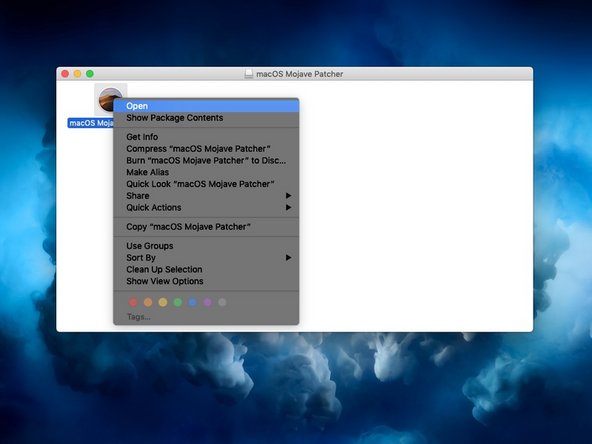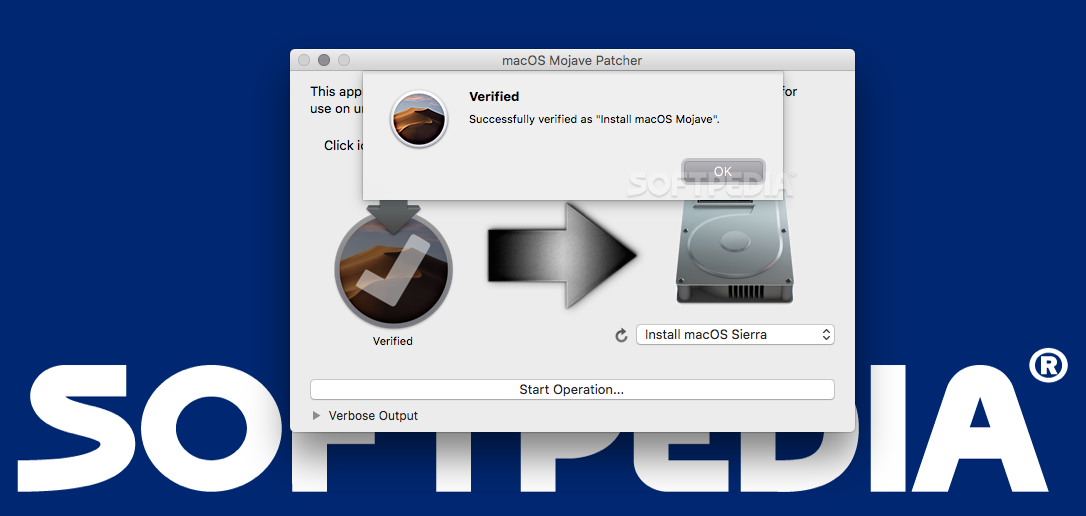. Download the latest version of Mojave Patcher. Download the installer using the Tools menu of Mojave Patcher. Create a patched USB installer. Boot from that, and install 10.14.1 onto the volume containing an older release. Once done, apply the post-install patches, and you should now be on 10.14.1. Hackintosh Mojave Installer supports AMD: Normally, computers that use AMD processors are unsupported by Mac OS X. However, Hackintosh Mojave Installer includes experimental “patched” kernels that may allow Mac OS X to work with these processors regardless.
You'll need a very good reason and it'd be best if you didn't do it on your main Mac. However, installing Mojave on some older Macs can be done — and fairly easily. AppleInsider explains if you really must know.
This year's macOS Mojave beta, and subsequent update, won't run and can't be installed on any Mac older than about 2012 — or so Apple thinks. However, if you're the sort to believe that every year Apple tries to force everyone to buy new Macs, and you also forget that 2012 was six years ago, you're in luck.
But, there is now a way to ignore Apple and install macOS Mojave on any Mac you like. Or at least any Mac you like back to around 2008.
There are exceptions. The new and most utterly not Apple supported macOS Mojave Patcher Tool will even go back to 2007 if you have a very specific iMac that you've already upgraded in a very specific way. That said, Apple's official list also has exceptions: if you have the right Mac Pro you can install Mojave on even a mid-2010 machine.
We get that you may well not be able to afford a new Mac. These are far from cheap machines. Plus even a ten-year-old MacBook Pro is a good computer and we'd not be at all surprised if you were still getting great use out of it.
We would just then be surprised that you want to risk that great use by installing a macOS update that it can't handle.
The Mojave Patcher Tool for Unsupported Macs is available for download from DosDude1. This is the same guy that did this for High Sierra, and has supplied a series of other hacks and workarounds for fans of older Apple hardware.
Doubtlessly the tool is a clever piece of programming that is be far beyond our skill, but ultimately it just does one thing — it prevents Apple's macOS installation tool from spotting that the machine you're using is too old.
Other than that, it takes macOS Mojave and installs it on a drive. But, if you're now wondering where it gets Mojave from, you've spotted a potential hang-up in the process.
To get a copy of macOS Mojave to install on an unsupported Mac, you have to be in the Apple Beta program but more importantly than that, you have to download it on a supported Mac.
So, unless you've got friends who have newer Macs yet not enough conscience to warn you off this idea because it is potentially hazardous to your data and hardware, you've got to personally have a Mojave-capable Mac. If you have, go ahead, use Mojave on that.
Normally we'd be hesitant about that too. Apple's macOS, like any operating system, is so complex that it's bound to have some problems on older gear. Every year we generally advise you to wait a little while before installing the final version. Every year we also point out that installing the beta is fine so long as you do it on a spare Mac.

We say both of those things about Macs that are supposed to be able to run these things. Even when they are, the advice to wait for a while after official release is a good suggestion. The advice to stay away from the beta versions entirely on a critical work machine is more like a firm rule.
If you use this tool to install macOS Mojave on a Mac that Apple itself says won't work, you can't honestly expect a great experience. You're not going to transform that brilliant 2008 MacBook Air into a 2018 model. You're more likely to transform it into a somewhat less brilliant 2008 brick under more load than the hardware should have to bear.
It is good to have the same macOS on all of your machines, and it's even slightly disorientating when you're swapping between Mojave and Sierra. However, take the disorientation because it's better than having no functioning Mac at all.
One more thing. If you do use this patch tool to install macOS Mojave on your main Mac, please remember that you can still read AppleInsider on your iPhone if things go awry.
AppleInsider has affiliate partnerships and may earn commission on products purchased through affiliate links. These partnerships do not influence our editorial content.
In the past few years, the Hackintosh community has grown pretty fast and is still growing rapidly. Most of the people prefer macOS over windows when it comes to running productivity software, as they are more stable and some apps are available for macOS only. While creating a bootable macOS installer is a very straightforward and easy process but it can only be created from a macOS. Most of the people who want to build a Hackintosh don’t own a mac making building a Hackintosh a dream. In this tutorial, I will show you how you can install macOS Mojave on pc without having a mac.
Coming to macOS Mojave, it was launched by Apple in WMDC 2018. macOS Mojave brings the most awaited dark mode, along with many several new features as well as improvements to existing features. In macOS Mojave, Apple made APFS conversion enforced whether you are using SSD or HDD. In high sierra, there was an option through which you could avoid APFS conversion, but it was removed in macOS Mojave.
Download the required files.
Note: A USB drive with size 8gb or more is required to follow this tutorial.
Before starting the tutorial, download the required files to create the USB installer.
Extracting the DMG to the USB drive.
1. Install transmac and open it as an administrator.
2. Plug in your USB drive
3. Select the USB drive from the side menu and right-click it and then select “format disk for mac”.
Please note that this step will erase the USB drive
4. Again right-click the drive and select “restore with disk image”, select the macOS Mojave DMG file when prompted.
Now sit and relax as this will take some time like 10-20 minutes depending on the speed of the drive.
Note: After the restoration process is finished, Windows may prompt you to format the USB drive as HFS file system is not supported in Windows. Cancel the prompt.
Related: Install macOS mojave 10.14 on VMware on windows
Installing Clover
Now that the DMG is fully extracted into the USB we can now proceed to install clover. I have not included clover in the DMG as it gets outdated quickly and as now clover provides zip file option, you can now install it from windows without much hassle. Alternatively, you can use opencore bootloader instead of clover, but in this tutorial, we will use clover since it is easy to install and setup as compared to opencore.
At first download the latest clover zip from their official GitHub release page. Extract the zip and copy all the contents into EFI volume (In USB).
Clone or download the config files Github repo of rehabman, it contains config files for intel processors, these config files contain basic configuration, any device-specific patches that are required by your device to boot the installer should be enabled by yourself. According to your CPU architecture select a config file and rename it to “config.plist”. Then copy and replace the file to clover folder inside EFI (USB).

The latest versions of clover are shipped with all the drivers that are required to boot macOS. Some of the drivers are kept in the off directory which means they are disabled by default. To enable them you just need to copy the files from drivers/off/UEFI/* to drivers/UEFI. Some of the drivers you need to copy:
Since most of the modern motherboard uses UEFI, you only need to copy the files from and to UEFI.
1. FileSystem -> ApfsDriverLoader.efi, VBoxHFS.efi
2. MemoryFix -> OsxAptioFix3Drv.efi
In some rare cases, clover may not show APFS drives, which means that due to some reason ApfsDriverLoader is not working. You can use APFS.efi driver which is basically same but unlike ApfsDriverLoader which loads the apfs drives from macOS system, it contains the driver in itself.
Now the drivers are all set up, lets now install the required kexts. In order to boot the installer, you need to install the required kexts only. Any unnecessary kexts may cause a kernel panic and stop the installer from booting. The kexts we are installing are the most basic requirement for booting the installer. However, your device may need some additional kexts for it to install properly.
Download the following kexts:
1, FakeSMC.kext
2. VoodooPS2.kext
FakeSMC is the most essential kext for booting the macOS Mojave installer without it you will never boot, VoodooPS2 is for making keyboard and mouse working.
Any other required device-specific kexts should be also downloaded any installed. Remember that you should not install any unnecessary kexts.
Copy the downloaded kexts into EFI/EFI/CLOVER/Kexts/others/
Installing macOS Mojave
Mac Os Mojave Full Install
Now that the macOS Mojave installer is finished and ready to install on your device.
If you wish to dual boot macOS Mojave with windows 10 we have a very detailed guide to help you out!